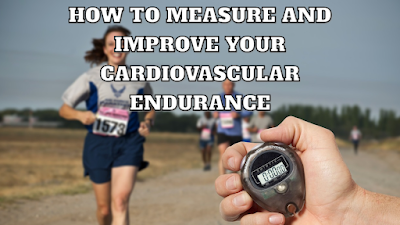How to Measure and Improve Your Cardiovascular Endurance. Cardiovascular endurance is a way to estimate your physical fitness level. It refers to how well your heart and lungs can supply oxygen to your muscles during moderate to high-intensity exercise. If you have good cardiovascular endurance, you can exercise longer and harder without getting tired. This can benefit your health, mood, and quality of life.
But how do you measure your cardiovascular endurance? And how can you improve it? In this blog post, we will answer these questions and give you some tips and examples of exercises that can boost your cardiovascular endurance.
## How to Measure Your Cardiovascular Endurance
One of the most common and accurate ways to measure your cardiovascular endurance is to measure your **VO2 max**. This is the maximum amount of oxygen that your body can consume and use during exercise. The higher your VO2 max, the better your cardiovascular endurance.
To measure your VO2 max, perform a **stress test** under medical supervision. A stress test involves exercising on a treadmill or a stationary bike while wearing a mask that measures your oxygen intake and carbon dioxide output. The intensity of the exercise is gradually increased until you reach your maximum effort. The test can also monitor your heart rate, blood pressure, and electrocardiogram (ECG).
A stress test can give you an accurate estimate of your VO2 max, but it can also be expensive and inconvenient. If you don't have access to a stress test, you can use other methods to estimate your VO2 max, such as:
**Beep Test**
This is a simple test that involves running between two points that are 20 meters (about 66 feet) apart while keeping a certain pace. The pace is determined by a recorded audio signal that beeps at regular intervals. You have to run faster as the beeps get closer together. The test ends when you can no longer keep up with the pace or when you complete 21 levels. You can use a formula to calculate your VO2 max based on the number of shuttles you completed.
**Cooper test**
This is another simple test that involves running as far as you can in 12 minutes. You can use a formula to calculate your VO2 max based on the distance you covered.
**Rockport walking test**
This is a test that involves walking one mile (1.6 kilometers) as fast as you can. You can use a formula to calculate your VO2 max based on your walking time, heart rate, weight, age, and gender.
These tests are more accurate than stress tests, but they can give you a rough idea of your cardiovascular endurance level. You can also use them to track your progress over time.
## How to Improve Your Cardiovascular Endurance
The best way to improve your cardiovascular endurance is to do regular **aerobic exercise**. Aerobic exercise is any activity that increases your heart rate and breathing rate for an extended period of time (typically over 20 to 30 minutes). Examples of aerobic exercise include Running, Cycling, Swimming, Rowing, Hiking, Dancing, Skipping rope, and Aerobics classes.
To improve your cardiovascular endurance, you should aim to do at least 150 minutes of moderate-intensity aerobic exercise or 75 minutes of high-intensity aerobic exercise per week. Moderate intensity means that you can talk but not sing while exercising. High intensity means you can only say a few words before pausing for breath.
You can also vary the intensity, duration, frequency, and type of aerobic exercise to challenge your body and prevent boredom. For example, you can try:
- **Interval training**: This involves alternating between short bursts of high-intensity exercise and longer periods of low-intensity exercise or rest. For example, you can run for one minute at 90% of your maximum effort, then walk for two minutes at 50% of your maximum effort, and repeat for 20 minutes.
- **Circuit training**: This involves doing different exercises in a sequence with little or no rest between them. For example, you can do 10 push-ups, 10 squats, 10 lunges, 10 burpees, and 10 sit-ups in a row, then rest for one minute and repeat for three rounds.
- **Cross-training**: This involves doing different types of aerobic exercise on different days or in the same session. For example, you can run on Monday, swim on Wednesday, and cycle on Friday. Or you can do 10 minutes of running, 10 minutes of cycling, and 10 minutes of rowing in one session.
These methods can help you improve your cardiovascular endurance by increasing the amount of oxygen that your body can consume and use during exercise. They can also improve other aspects of your fitness, such as your strength, flexibility, balance, and coordination.
## Conclusion
Cardiovascular endurance is a measure of your physical fitness that reflects how well your heart and lungs can supply oxygen to your muscles during exercise. It can benefit your health, mood, and quality of life. You can measure your cardiovascular endurance by doing a stress test or other tests that estimate your VO2 max. You can improve your cardiovascular endurance by doing regular aerobic exercise and varying the intensity, duration, frequency, and type of exercise. By following these tips, you can boost your cardiovascular endurance and enjoy the benefits of being fit and healthy.
**Reference**
This blog post is based on information from the following sources:
- Cleveland Clinic. (2021). Cardiovascular Endurance. Retrieved from https://my.clevelandclinic.org/health/articles/24754-cardiovascular-endurance
- WebMD. (2021). Cardiovascular Endurance: What It Is, and How to Improve It. Retrieved from https://www.webmd.com/fitness-exercise/what-is-cardiovascular-endurance
- Abbott. (2019). How to Have a Healthy Heart. Retrieved from https://www.abbott.com/corpnewsroom/healthy-heart/how-to-have-a-healthy-heart.html
- Biostrap. (n.d.). Cardiovascular Endurance: What It Is and How You Can Improve It. Retrieved from https://biostrap.com/academy/cardiovascular-endurance/
- Healthline. (2017). Cardiorespiratory Endurance: Tests and Exercises. Retrieved from https://www.healthline.com/health/cardiorespiratory-endurance

